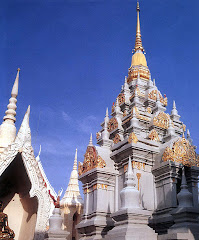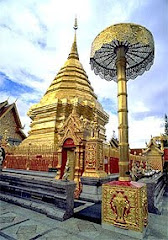 This temple was built in 1297 at the site of the camp King Mangrai used when he supervised the building of Chiang Mai. It was the first temple to be built in Chiang Mai and contains several very old artifacts. The oldest structure is the Chang Lom chedi, which is in a style that could have originated from Sri Lanka via Sukhothai, or from Pagan. Fifteen elephants represent a sea of unformed matter upon which the cosmos of the chedi floats.
This temple was built in 1297 at the site of the camp King Mangrai used when he supervised the building of Chiang Mai. It was the first temple to be built in Chiang Mai and contains several very old artifacts. The oldest structure is the Chang Lom chedi, which is in a style that could have originated from Sri Lanka via Sukhothai, or from Pagan. Fifteen elephants represent a sea of unformed matter upon which the cosmos of the chedi floats.
Nearby are a lotus pond, a raised scripture repository and an ubosot. The stela in front of the ubosot was inscribed in 1581, and is one of the oldest known records that establishes the founding date of Chiang Mai.
The temple has two Lanna style viharn. The larger viharn was renovated by Khru Ba Srivichai in the 1920's. The standing Buddha image (front right of the altar) has an inscription on its slightly lopsided square base that dates it to 1465. This makes it the oldest dated Buddha image to be found so far in Chiang Mai. Close study shows new gilt veneer covers pits and cracks that indicate the image's real age.
The smaller viharn to the north (open 09:00-17:00) contains two small but very famous Buddha images. The Phra Sila image is a bas-relief that probably came from Ceylon in about the eighth century. The image is believed to have the power to bring rain and is the focus of a festival at the temple held from April 1-5.
The Phra Sae Tang Khamani crystal image belonged to Queen Chamadevi, who brought it from Lop Buri when she became the first ruler of Haripunchai. The image reputedly survived the burning of Haripunchai when it was razed by King Mangrai, and is honored for its powers to protect against disaster.
source: www.chiangmai1.comTechnorati tags : Wat /Wat Chiang Man /Chiang Mai /Thailand/thai temple









No comments:
Post a Comment